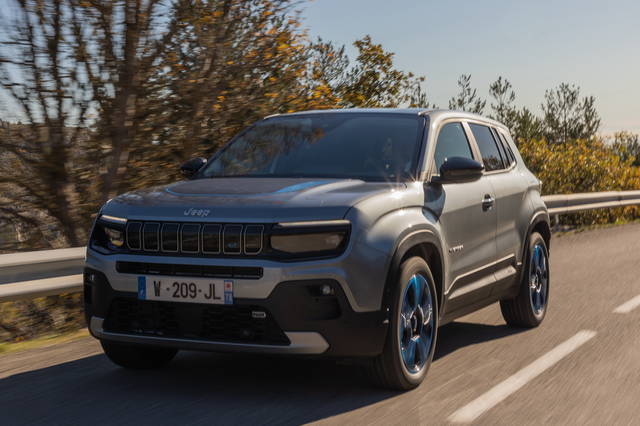We also use petrol
And here it is, thelittle Jeep”. Ready to accompany us in a preview test reserved for the Car of the Year jurors, the international award that every year (since 1964) identifies the most innovative car from a technological and design point of view, in relation to price, among those presented (and put up for sale) in the previous 12 months. It is the first time that we have the opportunity to evaluate the Jeep Avenger live, outdoors, after the debut at the recent Paris Salon (who the news). It is important, in order to get a realistic impression of a car, to observe it in natural light and in a normal road environment. Well, the little Jeep, which is the first designed outside the US, he has a nice presence and it doesn’t look like the Renegade’s “little sister” at all, despite being 16 cm shorter. Indeed, it has the momentum that is missing from that model, decidedly more stocky, and a look that in some details (the squared headlights and the engine hood raised in the central part) winks a bit to that of the Compass. The seven slits in the front, which have always been the calling card of the American company, are closed: the Avenger we saw (and drove for about sixty kilometers inland from Nice) is the one with the 156 HP electric motor.
The variant of Jeep Avenger with the three-cylinder 1.2 turbo 100 HP petrol engine and manual gearbox is reserved for Italy and Spain, where the energy transition does not proceed at the same pace as in the countries of Central and Northern Europe and “battery” cars are less widespread: it costs 26,900 euros in the rich 1st Edition set-up, while theelectric – in the same full-featured version that can be ordered until the end of the year – it saves money 39,500. For the latter, there is an eco-incentive of 5,000 euros. Both can be had with installment financing, respectively of 199 and 249 euros per month, “spread” in 48 installments with around 7,500 euros in advance and a final adjustment of 20,801 euros for the battery-powered one and 13,990 for the other.
Electric heart
The Jeep Avenger was born in the Polish factory of Tychy (where the petrol Fiat 500 and the Lancia Y are also produced) and is built on the eCMP platform of the Stellantis group, which allows – without too many complications – to use thermal or electric thrusters. The one chosen for the Avenger is a motor 400 volt, the first launched by Emotors (a joint venture between the Stellantis group and the French Nidec Leroy-Somer Holding). It is paired with a new one battery 54 “gross” kWh lithium-ion batteries (there are 51 that can actually be used). Composed of 17 modules and 102 cells, the battery pack is housed under the seats and the central tunnel, in a position also protected by precious underbody plates when off-road. According to the house, it offers 400 km of autonomy in the WLTP cycle, which becomes 550 in the city. The car accepts up to 100 kW in direct current, sufficient to recharge the accumulator from 20 to 80% in 24 minutes. Instead, using the alternating current of a wallbox or one of the most popular charging stations, the car accepts up to 11 kW: “full” (from 0 to 100% energy) is done in five and a half hours.
Strong color contrast
Before boarding we take a tour around the car. It has presence, this one Jeep Avengerand the merit also goes to the large 18” wheels: many, in relation to the external dimensions. The black roof makes it look more streamlined. The color also recurs in the lower part of the bodywork, protected by a plastic band that is one with the wheel arches and bumper shields. The rear pillar is typical of Jeeps, and a reference to tradition is also felt in the protruding mudguards and in the bonnet rounded on the side edges; the classic “X” can be seen in the rear lights, in homage (as in the Renegade) to the design of the military fuel cans of the first models of the house. The Avenger, however, looks above all to the future: it has LED matrix headlights (when switched off they resemble dark plates), a qualifying solution for a car in this category, and it is very “equipped” from a technological point of view. For example, it offers Level 2 semi-autonomous driving (the maximum allowed in Europe), as well as automatic emergency braking that recognizes cyclists and pedestrians and blind spot control of the mirrors. Still on the subject of Adas, we note the monitoring of the driver’s attention and the recognition of the speed limits indicated by road signs. Semi-automatic parking is expected at a later stage.
Generous of space
This is still a pre-series specimen (although already orderable, the Jeep Avenger electricity will be delivered from March 2023one month after the petrol one) and this must be taken into account: small inaccuracies in the finishes are the norm. From this point of view, however, the cockpit seems to us quite OK. Above all, the interior is quite spacious. Even behind, where, however, the ventilation vents and the handles in the ceiling are missing. Also absent are the pockets in the rear doors. It is explained to us that the car is largely intended for a young clientele (couples with one or at most two small children) who should not perceive these shortcomings as major gaps. Moreover, there are plenty of compartments in front (for a total of 34 litres) including a long shelf in front of the passenger for storing the most frequently used objects.
What really strikes, in the new Jeep Avengerit is the simple and rational style of the furnishings: the coloured, thin and visually light dashboard supports a nice 10.3” central display for the multimedia system; the 10.3” digital dashboard behind the three-spoke steering wheel is widely configurable and very easy to read (showing, among other things, the battery charge status). Immediately below the gold-colored insert that houses the air diffusers is the wide band in not exactly soft black plastic (better, however, than the rigid and light one used for the upper part of the dashboard) with in the center, easy to reach, the rocker controls. They are those for the “climate” (automatic but single-zone, it can also be managed from the central screen), the starter and the four emergency lights.
Further down, clearly visible, are the buttons for forward or reverse gear, for neutral and the parking position, on the platform that surmounts the large compartment, provided with a magnetic cover similar to that of tablet covers. Between the seats there is instead the control of the six driving modes and, next to it, the lever of the parking brake. The eco-leather upholstery of the armchairs and the non-sliding sofa (a rarity in this category) are pleasant, as are the side door panels. Designed to be easily washed, the interiors are embellished with ambient lights that can be selected in eight colours, which give the whole a hi-tech touch. Let’s also take a look at the trunk of the Jeep Avengerwhich is quite well-finished and average in terms of capacity (355 liters with the sofa in the position of use, while the maximum load capacity is not declared). The variable height top is practical, but in the electric version the compartment below can only house the “inflate & repair” kit for tyres.
He immediately gives confidence in the guide
The seats of the Jeep Avenger they are comfortable, quite enveloping and well adjustable. The driving position is high, but slightly less than in the Renegade: it allows excellent front and side visibility, while backwards you have to deal with the small rear window (which is not a problem, given that the distance sensors and the camera are standard). Let’s check the mirrors, and off we go: the test can begin. The first sensation is that of great ease of driving. This car immediately puts you at ease. We move in Normal mode: the others for driving on asphalt are called Eco and Sport, while for off-road there are programs dedicated to mud, snow and sand. The steering is light but precise, the response to the accelerator linear: no “thump of power”, the 156 HP are delivered without jerks, with a very manageable progression, in the usual silence that distinguishes electrics. We do not hear any annoying creaks or noises, the acoustic comfort seems good. The suspensions (McPherson at the front, torsion beam at the rear) also do a good job with a non-yielding but not too rigid calibration.
The road that climbs the hills becomes narrow and winding, but in terms of driving precision and handling the Jeep Avenger he knows his stuff. The kilometers flow by like a pleasure, and when the climb becomes more demanding we switch to Sport mode: the steering acquires consistency, the thrust becomes more full-bodied. Then the ribbon of asphalt descends, halfway up the slope, alternating long straight stretches, curves and hairpin bends. It’s time to take advantage of the regenerative brakingwhich is always active during deceleration and can be accentuated, for one pedal-style driving, by pressing a button: it slows down the car considerably and combines effectively with the work of the disc brakes.
And off-road?
The small one Jeep Avenger is also equipped with a device that allows you to maintain the set speed on steep descents, a very off-road solution that you will be able to appreciate more in the 4×4 (presented as a concept at the Paris Motor Show, who read more, and on sale in late 2023). Also version a front-wheel drivehowever, it can play good off-road cards (otherwise which Jeep would it be?): the section we are facing today is a short and undemanding dirt road, just a taste to test the “Mud” driving mode (effective!); in any case, the car should have excellent chances given the minimum ground clearance of over 20 cm and the favorable angles of attack (20°), break-over (20°) and departure (32°) obtained also thanks to the short overhangs.
Back on the asphalt, we face the streets of Grasse, which are beginning to fill up with traffic, and a few stretches in the surroundings, to start concluding this test, which we repeat, is only a preview while waiting for the more in-depth tests that we will be able to offer you in the coming months, including the one with the instrumental measurements of performance and consumption. In this regard, for now we have to make do with the on-board computer, which at the end of 66 kilometers (travelled at an average speed of 41 km/h) indicates a average consumption of 5.9 kWh per km and 80% charge still in the battery. Not bad.
In our opinion
PLEASE
> Adas. The latest generation of driving assistance systems are all there.
> Drawing. Great attention has been paid to the Jeep identity, both inside and out.
> Guide. Agile and safe, the car drives with pleasure. And it’s not in awe in the light off-road.
DEFECTS
> Air conditioning. It is automatic, but only single zone. And no rear vents.
> Plank trim. The upper part is made of a slightly too stiff and light plastic.
> Handles in the ceiling. Those for those occupying the rear sofa are missing.


